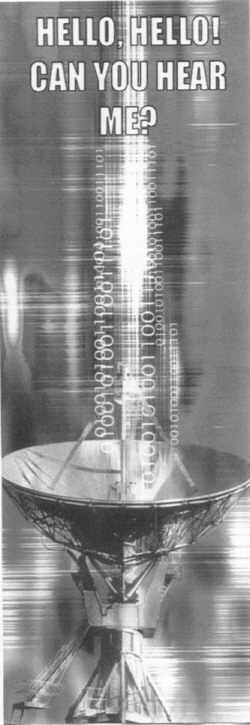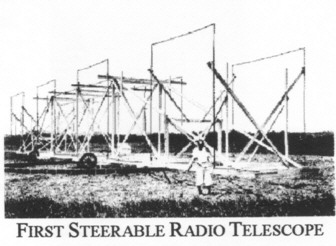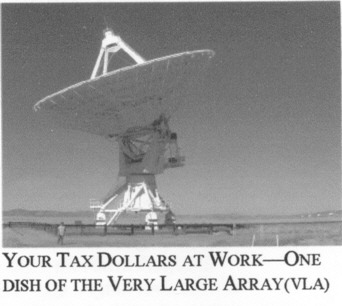Hello, hello!
Can you hear me?
by Robert James Jackson
 Radio Astronomy Began
As An Accident. Bell Telephone scientists Arno Penzias and Robert Wilson were trying to locate a persistent source of static coming from the sky. The only clue they had in the beginning of their investigation was that the source moved across the sky, not in 24 hours,
but in a sidereal time period--that is, at the same rate that the stars traversed
our night sky as the Earth rotates and revolves around the Sun. They realized that the source was
from the celestial realm, not from
Radio Astronomy Began
As An Accident. Bell Telephone scientists Arno Penzias and Robert Wilson were trying to locate a persistent source of static coming from the sky. The only clue they had in the beginning of their investigation was that the source moved across the sky, not in 24 hours,
but in a sidereal time period--that is, at the same rate that the stars traversed
our night sky as the Earth rotates and revolves around the Sun. They realized that the source was
from the celestial realm, not from
Earth's atmosphere.
Radio waves from space, gamma, x-ray, microwave and radio frequency wavelengths revealed we live in a wildly chaotic and violent universe. Black holes at the center of galaxies suck in suns by the
handful. Exploding supermassive stars wreak havoc on their stellar neighborhood, then collapse into a city-sized neutron star, or a singularity surrounded by the eternal 'no-peek'
curtain of its event horizon. City-sized collapsed neutron stars spin on their axis, each turn taking only a fraction of a
second. At "hot spots" on their surface, powerful beams of focused radio energy scythe through the interstellar medium, heard in our radio telescope receiver's audio output as a
perpetual buzz.
Of special interest to astronomers are the massive dark clouds of interstellar gas and
dust collapsing to form stars, and the hot, rapidly expanding clouds from supernovae. Wrapped in an
opaque cocoon of gas and dust, new stars are being born, not observed by visible light, but only by their infrared and radio emissions.
Like a person with eyes, but no ears, earlier astronomers could only see what is revealed by an extremely narrow bandwidth of visible lightwave frequencies. They did not "hear" the whispers, buzz and roar of celestial birth, life and death of unimaginably immense structures swarming through the Cosmos. Today,
thanks to electronic marvels; IC chips, CCD cameras, and the ubiquitous computer,
Astronomers cast a wide-band net to snare the muttering of the universe, and are making
swift progress in interpreting the language of creation and destruction, the
electromagnetic voice of a cosmic Rosetta Stone.
 The most common radio frequency used is the 21 centimeter wavelength--8-1/4 inches--nearly the same as the frequency in your microwave oven. This is the radio wavelength created by an excited hydrogen hydroxyl
molecule (water). By a fortunate circumstance, there is almost no Cosmic static generated at this frequency. There is a "hole" of silence,
so astronomers named this frequency "The water hole".
The most common radio frequency used is the 21 centimeter wavelength--8-1/4 inches--nearly the same as the frequency in your microwave oven. This is the radio wavelength created by an excited hydrogen hydroxyl
molecule (water). By a fortunate circumstance, there is almost no Cosmic static generated at this frequency. There is a "hole" of silence,
so astronomers named this frequency "The water hole".

The most difficult problem radio astronomers have to cope with is signals generated by intelligent life in the
universe--US! Our human technology fills our early niche with a roar of radio noise, drowning out the faint, sibilant whispers from celestial events. At the National Radio Telescope Observatory at Greenbank, West Virginia, the telescope dish is shielded from noise by being located in a valley, sheltered by surrounding hills and a federally-mandated "radio silence zone." The ideal location will be, of course, to build
enormous radio telescopes on the far side of the Moon.
For more information on radio astronomy, visit:
The Society of Amateur Radio Astronomers
http://radio-astronomy.org/index.html
Radio Sky Publishing
http://www.radiosky.com/
Amateur Radio Astronomy
https://www.qsl.net/wc9c/ras/ras.htm
[Return to Top]
[Go to Home Page]
Copyright © 2005 Muskegon Astronomical Society, Inc.
This web page was last updated 12/19/19
 Radio Astronomy Began
As An Accident. Bell Telephone scientists Arno Penzias and Robert Wilson were trying to locate a persistent source of static coming from the sky. The only clue they had in the beginning of their investigation was that the source moved across the sky, not in 24 hours,
but in a sidereal time period--that is, at the same rate that the stars traversed
our night sky as the Earth rotates and revolves around the Sun. They realized that the source was
from the celestial realm, not from
Radio Astronomy Began
As An Accident. Bell Telephone scientists Arno Penzias and Robert Wilson were trying to locate a persistent source of static coming from the sky. The only clue they had in the beginning of their investigation was that the source moved across the sky, not in 24 hours,
but in a sidereal time period--that is, at the same rate that the stars traversed
our night sky as the Earth rotates and revolves around the Sun. They realized that the source was
from the celestial realm, not from The most common radio frequency used is the 21 centimeter wavelength--8-1/4 inches--nearly the same as the frequency in your microwave oven. This is the radio wavelength created by an excited hydrogen hydroxyl
molecule (water). By a fortunate circumstance, there is almost no Cosmic static generated at this frequency. There is a "hole" of silence,
so astronomers named this frequency "The water hole".
The most common radio frequency used is the 21 centimeter wavelength--8-1/4 inches--nearly the same as the frequency in your microwave oven. This is the radio wavelength created by an excited hydrogen hydroxyl
molecule (water). By a fortunate circumstance, there is almost no Cosmic static generated at this frequency. There is a "hole" of silence,
so astronomers named this frequency "The water hole".
